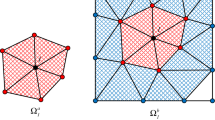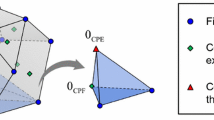Abstract
This paper presents a smoothed FE-Meshfree (SFE-Meshfree) method for solving solid mechanics problems. The system stiffness matrix is calculated via a strain-smoothing technique with the composite shape function, which is based on the partition of unity-based method, combing the classical isoparametric quadrilateral function and radial-polynomial basis function. The corresponding Gauss integration in the element is replaced by line integration along the edges of the smoothing cells, so no derivatives of the composite shape functions are needed during the field gradient estimation process. Several numerical examples including an automobile mechanical component are employed to examine the presented method. Calculation results indicate that SFE-Meshfree can obtain a high convergence rate and accuracy without introducing additional degrees of freedom to the system. In addition, it is also more tolerant with respect to mesh distortion. The volumetric locking problem is also explored in this paper under a selective smoothing integration scheme.
Similar content being viewed by others
References
Zienkiewicz, O.C., Taylor, R.L.: The Finite Element Method, 5th edn. Butterworth-Heinemann, Oxford (2000)
Lee, N.S., Bathe, K.J.: Effects of element distortions on the performance of isoparametric elements. Int. J. Numer. Methods Eng. 36(20), 3553–3576 (1993)
Zeng, W., Liu, G.R.: Smoothed finite element methods (S-FEM): an overview and recent developments. Arch. Comput. Methods Eng. (2016). https://doi.org/10.1007/s11831-016-9202-3
Gingold, R.A., Monaghan, J.J.: Smoothed particle hydrodynamics: theory and application to non-spherical stars. Mon. Not. R. Astron. Soc. 181(3), 375–389 (1977)
Belytschko, T., Lu, Y.Y., Gu, L.: Element-free Galerkin methods. Int. J. Numer. Methods Eng. 37(2), 229–256 (1994)
Liu, W.K., Jun, S., Zhang, Y.F.: Reproducing kernel particle methods. Int. J. Numer. Methods Fluids 20(8–9), 1081–1106 (1995)
Atluri, S.N., Zhu, T.: A new meshless local Petrov–Galerkin (MLPG) approach in computational mechanics. Comput. Mech. 22(2), 117–127 (1998)
Mirzaei, D., Hasanpour, K.: Direct meshless local Petrov–Galerkin method for elastodynamic analysis. Acta Mech. 227(3), 1–14 (2016)
Liu, G.R., Gu, Y.T.: A point interpolation method for two-dimensional solids. Int. J. Numer. Methods Eng. 50(4), 937–951 (2001)
Liu, G.R., Gu, Y.T.: A local radial point interpolation method (LRPIM) for free vibration analyses of 2-D solids. J. Sound Vib. 246(1), 29–46 (2001)
Shojaei, A., Mossaiby, F., Zaccariotto, M., et al.: The meshless finite point method for transient elastodynamic problems. Acta Mech. 2, 1–13 (2017)
Zhang, B.R., Rajendran, S.: ‘FE-Meshfree’ QUAD4 element for free-vibration analysis. Comput. Methods Appl. Mech. Eng. 197(45), 3595–3604 (2008)
Zheng, C., Wu, S.C., Tang, X.H., et al.: A novel twice-interpolation finite element method for solid mechanics problems. Acta. Mech. Sin. 26(2), 265–278 (2010)
Liu, G.R., Gu, Y.T.: Meshless local Petrov–Galerkin (MLPG) method in combination with finite element and boundary element approaches. Comput. Mech. 26(6), 536–546 (2000)
Rabczuk, T., Xiao, S.P., Sauer, M.: Coupling of mesh-free methods with finite elements: basic concepts and test results. Int. J. Numer. Methods Biomed. Eng. 22(10), 1031–1065 (2006)
Chen, J.S., Wu, C.T., Yoon, S., et al.: A stabilized conforming nodal integration for Galerkin mesh-free methods. Int. J. Numer. Methods Eng. 50(2), 435–466 (2001)
Liu, G.R., Dai, K.Y., Nguyen, T.T.: A smoothed finite element method for mechanics problems. Comput. Mech. 39(6), 859–877 (2007)
Lee, K., Lim, J.H., Sohn, D., et al.: A three-dimensional cell-based smoothed finite element method for elasto-plasticity. J. Mech. Sci. Technol. 29(2), 611–623 (2015)
Liu, G.R., Nguyen, T.T., Nguyen, X.H., et al.: A node-based smoothed finite element method (NS-FEM) for upper bound solutions to solid mechanics problems. Comput. Struct. 87(1), 14–26 (2009)
Nguyen, T.T., Vu-Do, H.C., Rabczuk, T., et al.: A node-based smoothed finite element method (NS-FEM) for upper bound solution to visco-elastoplastic analyses of solids using triangular and tetrahedral meshes. Comput. Methods Appl. Mech. Eng. 199(45), 3005–3027 (2010)
Liu, G.R., Nguyen, T.T., Lam, K.Y.: An edge-based smoothed finite element method (ES-FEM) for static, free and forced vibration analyses of solids. J. Sound Vib. 320(4), 1100–1130 (2009)
He, Z.C., Li, G.Y., Zhong, Z.H., et al.: An edge-based smoothed tetrahedron finite element method (ES-T-FEM) for 3D static and dynamic problems. Comput. Mech. 52(1), 221–236 (2013)
Nguyen, T.T., Liu, G.R., Lam, K.Y., et al.: A face-based smoothed finite element method (FS-FEM) for 3D linear and geometrically non-linear solid mechanics problems using 4-node tetrahedral elements. Int. J. Numer. Methods Eng. 78(3), 324–353 (2009)
Liu, G.R., Nguyen, T.T., Lam, K.Y.: A novel alpha finite element method (\(\alpha \)FEM) for exact solution to mechanics problems using triangular and tetrahedral elements. Comput. Methods Appl. Mech. Eng. 197(45), 3883–3897 (2008)
Zeng, W., Liu, G.R., Li, D., et al.: A smoothing technique based beta finite element method (\(\beta \)FEM) for crystal plasticity modeling. Comput. Struct. 162, 48–67 (2016)
Babuška, I., Melenk, J.M.: Partition of unity method. Int. J. Numer. Methods Eng. 40, 727–758 (1997)
Melenk, J.M., Babuška, I.: The partition of unity finite element method: basic theory and applications. Comput. Methods Appl. Mech. Eng. 139(1–4), 289–314 (1996)
Cai, Y., Zhuang, X., Zhu, H.: A generalized and efficient method for finite cover generation in the numerical manifold method. Int. J. Comput. Methods 10(05), 1350028 (2013)
Zheng, H., Xu, D.: New strategies for some issues of numerical manifold method in simulation of crack propagation. Int. J. Numer. Methods Eng. 97(13), 986–1010 (2014)
Oden, J.T., Duarte, C.A.M., Zienkiewicz, O.C.: A new cloud-based hp finite element method. Comput. Methods Appl. Mech. Eng. 153(1–2), 117–126 (1998)
Strouboulis, T., Babuška, I., Copps, K.: The design and analysis of the generalized finite element method. Comput. Methods Appl. Mech. Eng. 181(1), 43–69 (2000)
Schweitzer, M.A.: Stable enrichment and local preconditioning in the particle-partition of unity method. Numer. Math. 118(1), 137–170 (2011)
Belytschko, T., Gracie, R., Ventura, G.: A review of extended/generalized finite element methods for material modeling. Modell. Simul. Mater. Sci. Eng. 17(4), 043001 (2009)
Amiri, F., Anitescu, C., Arroyo, M., et al.: XLME interpolants, a seamless bridge between XFEM and enriched meshless methods. Comput. Mech. 53(1), 45–57 (2014)
Rajendran, S., Zhang, B.R.: A “FE-Meshfree” QUAD4 element based on partition of unity. Comput. Methods Appl. Mech. Eng. 197(1), 128–147 (2007)
Rajendran, S., Zhang, B.R.: Corrigendum to “a ‘FE-Meshfree’ QUAD4 element based on partition of unity” [Comput. Methods Appl. Mech. Eng. 197, 128–147 (2007)]. Comput. Methods Appl. Mech. Eng. 197(13), 1430–1430 (2008)
Xu, J.P., Rajendran, S.: A ‘FE-Meshfree’ TRIA3 element based on partition of unity for linear and geometry nonlinear analyses. Comput. Mech. 51(6), 843–864 (2013)
Tang, X., Zheng, C., Wu, S., et al.: A novel four-node quadrilateral element with continuous nodal stress. Appl. Math. Mech. 30(12), 1519–1532 (2009)
Yang, Y., Tang, X., Zheng, H.: A three-node triangular element with continuous nodal stress. Comput. Struct. 141, 46–58 (2014)
Yang, Y., Chen, L., Tang, X., et al.: A partition-of-unity based ‘FE-Meshfree’ hexahedral element with continuous nodal stress. Comput. Struct. 178, 17–28 (2017)
Cai, Y., Zhuang, X., Augarde, C.: A new partition of unity finite element free from the linear dependence problem and possessing the delta property. Comput. Methods Appl. Mech. Eng. 199(17), 1036–1043 (2010)
Xu, J.P., Rajendran, S.: A partition-of-unity based ‘FE-Meshfree’ QUAD4 element with radial-polynomial basis functions for static analyses. Comput. Methods Appl. Mech. Eng. 200(47), 3309–3323 (2011)
Yang, Y., Bi, R., Zheng, H.: A hybrid ‘FE-Meshless’ QUAD4 with continuous nodal stress using radial-polynomial basis functions. Eng. Anal. Bound. Elem. 53, 73–85 (2015)
Yang, Y., Xu, D., Zheng, H.: A partition-of-unity based ‘FE-Meshfree’ triangular element with radial-polynomial basis functions for static and free vibration analysis. Eng. Anal. Bound. Elem. 65, 18–38 (2016)
Yang, Y., Tang, X., Zheng, H.: Construct ‘FE-Meshfree’ QUAD4 using mean value coordinates. Eng. Anal. Bound. Elem. 59, 78–88 (2015)
Yang, Y., Xu, D., Zheng, H.: Application of the three-node triangular element with continuous nodal stress for free vibration analysis. Comput. Struct. 169, 69–80 (2016)
Yang, Y., Chen, L., Xu, D., et al.: Free and forced vibration analyses using the four-node quadrilateral element with continuous nodal stress. Eng. Anal. Bound. Elem. 70, 1–11 (2016)
Rajendran, S., Zhang, B.R., Liew, K.M.: A partition of unity-based ‘FE-Meshfree’ QUAD4 element for geometric non-linear analysis. Int. J. Numer. Methods Eng. 82(12), 1574–1608 (2010)
Yang, Y., Sun, G., Zheng, H.: Application of the “FE-Meshfree” QUAD4 with continuous nodal stress using radial-polynomial basis functions for vibration and geometric nonlinear analyses. Eng. Anal. Bound. Elem. 78, 31–48 (2017)
Yao, L., Tian, W., Li, L., et al.: Numerical investigations of a partition-of-unity based “FE-Meshfree” QUAD4 element with radial-polynomial basis function for acoustic problems. Appl. Math. Model. 40(13), 6199–6217 (2016)
Golberg, M.A., Chen, C.S., Bowman, H.: Some recent results and proposals for the use of radial basis functions in the BEM. Eng. Anal. Bound. Elem. 23(4), 285–296 (1999)
Timoshenko, S.P., Goodierwrited, J.N.: Theory of Elasticity, 3rd edn. McGraw-Hill, New York (1970)
Dinis, L.M.J.S., Jorge, R.M.N., Belinha, J.: Composite laminated plates: a 3D natural neighbor radial point interpolation method approach. J. Sandw. Struct. Mater. 12(2), 119–138 (2010)
Dinis, L.M.J.S., Jorge, R.M.N., Belinha, J.: Analysis of 3D solids using the natural neighbour radial point interpolation method. Comput. Methods Appl. Mech. Eng. 196(13–16), 2009–2028 (2007)
Cook, R.D.: Improved two-dimension finite element. J. Struct. Div. 100(9), 1851–1863 (1974)
Hughes, T.R.: The Finite Element Method: Linear Static and Dynamic Finite Element Analysis. Prentice-Hall, New York (2000)
Nguyen, T.T., Liu, G.R., Dai, K.Y., et al.: Selective smoothed finite element method. Tsinghua Sci. Technol. 12(5), 497–508 (2007)
Acknowledgements
This work was supported by the National Natural Science Foundation of China under Grant No. 11472137.
Author information
Authors and Affiliations
Corresponding author
Rights and permissions
About this article
Cite this article
Chen, G., Qian, L., Ma, J. et al. Smoothed FE-Meshfree method for solid mechanics problems. Acta Mech 229, 2597–2618 (2018). https://doi.org/10.1007/s00707-018-2124-4
Received:
Revised:
Published:
Issue Date:
DOI: https://doi.org/10.1007/s00707-018-2124-4




